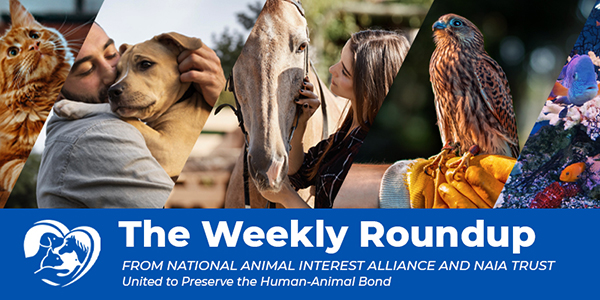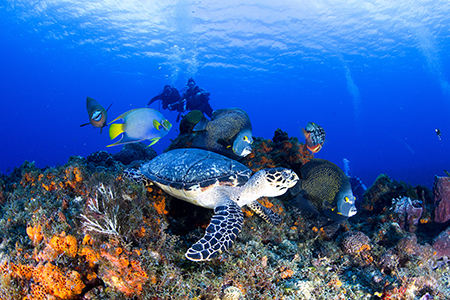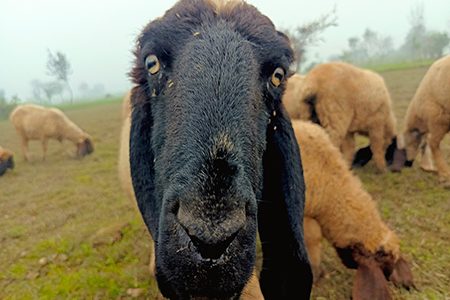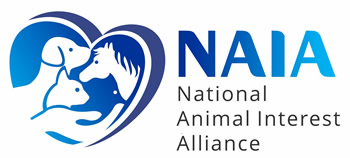
Inside This Issue:
- Breeding Corals in Aquariums to Keep Them Alive in the Wild
- Owners of Importing Shelter Charged with Animal Cruelty, Over 90 Dogs Seized
- Just Force Landlords to Accept Pets. Problem Solved, Right? Wrong.
- Message from Our Animals: Your Plans Mean Nothing to Us!
- AI and Drones Deployed in Bid to Restore Island
Breeding Corals in Aquariums to Keep Them Alive in the Wild

Meanwhile, in the Gulf of Mexico...
Coral reefs are known for their brilliant biodiversity and importance to sea life. They act as the lungs of marine environments and their overall well-being is a litmus test for ocean health. Corals in the Gulf of Mexico are facing several threats including, but not limited to pollution, over harvesting, rising temperatures, disease, rising acidity, and invasive species. As you can imagine, these iconic colonial invertebrates are dealing with a lot right now.
Marine scientists have developed ways to help propagate corals in human care in order to help repopulate troubled reef areas. Places like the Florida Aquarium in Tampa and now Moody Gardens in Galveston are working on coral breeding. Moody Gardens biologists are keeping five different species of corals from a federally protected area in the Gulf of Mexico fed and maintaining their “coral bank.” They have discovered that the Texas corals do require different growth parameters than their Florida relatives. Learning the nuances of what each coral needs is essential to saving them in the wild. If the wild corals begin to die off, those areas can be repopulated with colonies from the successfully kept banks in aquariums. Unfortunately, oceans are changing so rapidly, we may not be able to discover what makes corals resilient to disease and warming temperatures in time. Finding those strengths while they are being kept and bred in aquariums is essential.
Rescued Gulf of Mexico coral in a Galveston aquarium could help the species’ survival
Resources
★ A mysterious disease is killing off coral in the Gulf of Mexico. The feds just released a plan.
★ (2016) Murky Waters
Owners of Importing Shelter Charged with Animal Cruelty, Over 90 Dogs Seized.
In a story that has become all-too-common, more than 90 mistreated dogs were seized from a self-described animal rescue earlier this week. The owners were charged with animal cruelty. Conditions on their property revealed not only severely neglected dogs but several dogs that had already died. The seized dogs were suffering from dangerously unsanitary conditions as well as some untreated injuries and illnesses. If you take out the word “animal rescue,” this story reads almost word-for-word like one of the high-profile “puppy mill bust” stories we’d read about in 2009, which really speaks to a shift in how dogs are currently being sourced, as well as which sources are facing more regulations and scrutiny.
Of particular interest is the fact that this rescue group, despite being overwhelmed with nearly 100 dogs that they were clearly unable to care for, was still raising funds to import stray dogs from Egypt – and apparently, they managed to fly four of these dogs into their facility just last week. If you can’t trust a group to provide for the health and safety of the animals they already have, you certainly can’t trust them with animals that could pose a threat to public health and safety! Sheesh. Not that you need us to remind you, but this kind of nonsense is why passing the Healthy Dog Importation Act is so important.
Authorities seize nearly 100 maltreated dogs from Vernon rescue group
Resources
★ Rabies in a Dog Imported from Egypt — Kansas, 2019
★ The Healthy Dog Importation Act
Just Force Landlords to Accept Pets. Problem Solved, Right? Wrong.

Some of Our Best Friends Love Property Damage.
Pet ownership makes the housing crisis more difficult to navigate, especially for renters. There are a lot of rental units that won’t accept pets, or that only allow certain types and/or numbers of pets. And then, even if pets are allowed, a potential tenant may still be priced out of a desirable unit due to pet deposits and fees. This means that in some cases, pet lovers who move due to economic struggles, are forced to downsize more than their homes: they also have to give up some or all of their pets.
This is an awful situation to be in – talk about being kicked when you’re down! – and it not only separates pets and their people, it also puts a strain on the friends, family, rescues, agencies, and organizations that become responsible for these relinquished animals.
We can all agree that in a better world, nobody would feel like they have to make a choice between housing and keeping their dog – and we should work toward making that happen.
So, as long as we’re in our “better world” thinking mode, why not just force landlords to accept tenants with cats and dogs, while limiting pet fees and deposits? Wouldn’t that solve everything? That, in a nutshell, is what a new, HSUS-sponsored California Assembly Bill is opening the door to. And the answer, of course, is "No!" Aside from the creepy, touchy-feely totalitarianism at its core, telling landlords that they must make all rental units reasonably “pet friendly” wishes away a lot of issues that this will inevitably stir up.
Just because most of us love pets doesn’t mean that they don’t cause problems. Pets can cause massive amounts of property damage – especially bored dogs in areas with limited space for daily walks and exercise. Pets can also be noisy, exacerbate allergies, and even injure other tenants. There is also the sad fact that a lot of pet owners simply don't responsibly supervise and care for their animals (obviously this isn't always a choice on the pet owner's part, but damage and nuisances occur regardless). This is always viewed as a grumpy, wet blanket thing to say, but nothing in life is free, and one way or another, these costs will be passed on to all tenants – many of whom are already struggling to pay rent. Even if we thought the idea of “just make landlords accept pets” was good, we simply don’t see it solving the problems it aims to fix. A more balanced approach to this issue will be necessary if we truly want to move closer to that better world where we all have pets and nobody is struggling with housing.
California Bill Would Require Landlords to Accept Pets
Resources
★ When a No-Pet Policy Isn’t Really a No-Pet Policy
★ Why Your Dog Is Destroying Your House and What to do About It
Message from Our Animals: Your Plans Mean Nothing to Us!

I am once again reminding you that time is a construct.
A lovely column in the Midwest Messenger reminds us that no matter how carefully we map out our day, no matter how disciplined we are at sticking to our schedules… our animals truly couldn’t care less about our plans. The author’s story is framed in agriculture. It involved a sick cow, escaped ewes, and how the day’s drama led to a missed deadline. But no matter what type of animals we live with, this tale is something we can all relate to.
When your cat becomes deathly ill, chances are it will be five minutes before you need to leave for work or five minutes after the veterinarian has closed for the day (it's never 10:00 am on Tuesday). And there’s a decent chance kitty saunters off – appearing just fine – five minutes after you’ve completely rearranged your day's schedule. And when your dog has a litter of pups, you can bet you won’t hear the first squeak until five minutes after you’ve finally hit REM sleep.
It's a universal experience for people who care for animals. Maybe it’s their special way of reminding us that clocks don’t matter as much as our bond with them, because when we’re able to help them through their trouble, it’s always worth the interruption.
Animals have no respect for schedules
Resources
★ Starbucks Manager Asks Worker to Change Day She Puts Dog Down So She Can Cover a Shift
★ Why Rochester pet lovers worry about the state of emergency veterinary services
AI and Drones Deployed in Bid to Restore Island

Beautiful. Also, a cat delicacy.
Wildlife on the Hawaiian Islands has long been in jeopardy from urbanization, environmental degradation, and the introduction of invasive species. Islands, with their smaller and typically more specialized species, are especially sensitive to being knocked out of balance, too, which brings additional challenges for conservationists.
This brings us to the small island of Kaho‘olawe off the coast of Maui. It is the smallest of the inhabited Hawaiian Islands and is known for its cultural and historical significance to the Native Hawaiian people. However, Kahoʻolawe holds a unique and tragic history. Once used as a target and training area by the U.S. military, the island suffered extensive environmental damage and cultural desecration. In 1990, the U.S. government designated Kahoʻolawe as a National Historic Landmark and transferred control of the island to the state of Hawaii. Since then, efforts have been made to restore the island's ecosystem and preserve its cultural heritage. Today, access to Kahoʻolawe is restricted, and only permitted for Native Hawaiian cultural, spiritual, and educational purposes.
Various organizations and groups are involved in restoration projects, aiming to revitalize the island's land and natural resources. Two groups, Conservation X Labs and Island Conservation, are working together to eradicate the island’s most troublesome pest - feral cats. These cats have decimated the native bird population, a key step in restoring the island. In addition, there are left over bombs from WW2 training drills that must be navigated around. This is where the technology from the conservation groups comes in - drones drop off AI-run cameras that sort through photo dumps to find the cats. It is a slow and expensive process, the cats still need to be found and eradicated. But there is hope. The project has been successful in other cat removal programs in island restoration efforts. Intertwined within all of this is the restoration of native Hawaiian culture and habitat.
On Kaho’olawe, new technology could restore a sacred Hawaiian island
Resources
★ Redefining Conservation: How Drones are Revolutionizing Island Restoration
★ Islands: Fragile showcases of biodiversity
Also in the News...
★ Whales can sing underwater without drowning—now we know how (Cetaceans; Bagpipe Larynxes; Noise Pollution)
★ Wildlife Wednesday: Collective nouns for groups of Michigan animals (Almost a List; More of an Article)
★ Steven M. Wise, legal force for animal rights, dies at 73 (Founder of Nonhuman Rights Project)
★ Critter Encounters encourages people to get up close and personal with animals (Hands-On Learning & Advocacy – Literally)
★ First Known Photos of ‘Lost Bird’ Captured by UTEP Scientists (Conservation; Expeditions & Research; Fantastic Photos)
★ Married Lee County couple arrested for beastiality; 4 animals seized (Pornographic Images; Horrific Abuse)
★ Miraculous Pregnancy: Parthenogenesis in a North Carolina Aquarium’s Stingray (For Something So Rare, We Sure Talk about Parthenogenesis a Lot)
Click here to see what is happening legislatively


